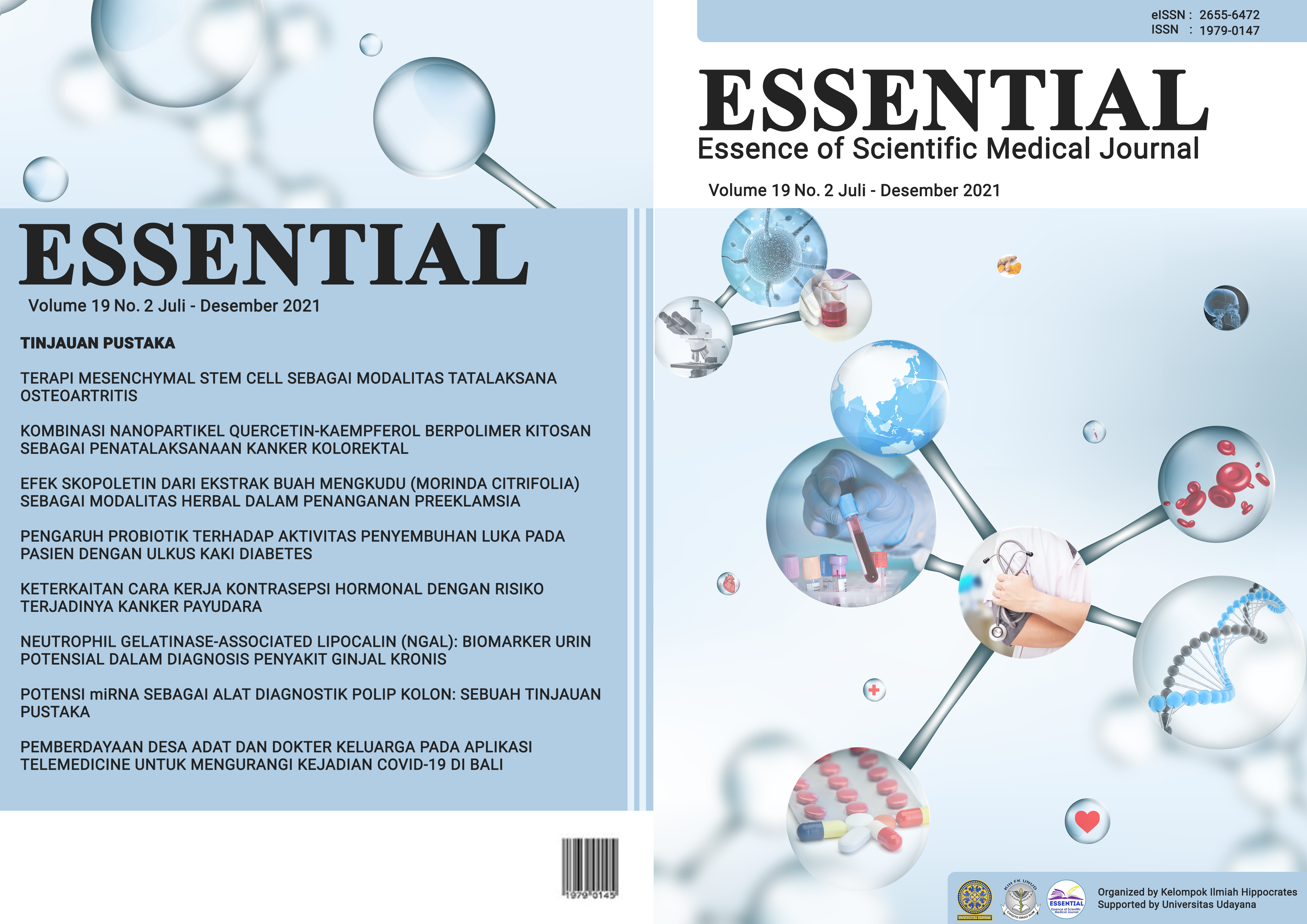POTENSI miRNA SEBAGAI ALAT DIAGNOSTIK POLIP KOLON: SEBUAH TINJAUAN PUSTAKA
Abstract
Introduction: Colonic polyps are distinct tissue growth inside the lumen of the colon and an expected precursor for the development of colorectal cancer. Prospective diagnostic modalities such as miRNA might be ideal to evaluate the progression. There are evidence from multiple studies that implied certain dysregulation of miRNA indicates pathologic changes regarding colonic polyps Aim: This review aims to provide overview of the diagnostic capabilities of miRNA in colon polyp and identify gaps of knowledge for further studies Method: A review based on Preferred Reporting Items for Systematic Reviews and Meta Analyses (PRISMA) was conducted with the database from Pubmed, Science Direct, and Proquest Result: A total of five studies has reported diagnostic accuracies of miRNA in distinguishing adenoma polyp and normal, adenoma polyp and hyperplastic polyp, sessile serrated adenoma/polyps and hyperplastic polyp, colon polyp and colorectal cancer. Conclusion: miRNAs could be a potential biomarker for colon polyp. Further diagnostics studies, in particular those with clinical values, need to be conducted.
Downloads
References
2. Ma Z, Kong X, Cui G, Ren C, Zhang Y, Fan S et al. Expression and Clinical Significance of miRNA-34a in Colorectal Cancer. Asian Pacific Journal of Cancer Prevention. 2014;15(21):9265-9270
3. Bonnington S. Surveillance of colonic polyps: Are we getting it right?. World Journal of Gastroenterology. 2016;22(6):1925
4. Ayundini G, Simadibrata M. Screening and Management of Colon Polyp as Colorectal Cancer Prevention. The Indonesian Journal of Gastroenterology, Hepatology, and Digestive Endoscopy. 2017;17(2):112],
5. Baran B, Mert Ozupek N, Yerli Tetik N, Acar E, Bekcioglu O, Baskin Y. Difference Between Left-Sided and Right-Sided Colorectal Cancer: A Focused Review of Literature. Gastroenterology Research. 2018;11(4):264- 273
6. Bray F, Ferlay J, Soerjomataram I, Siegel R, Torre L, Jemal A. Global cancer statistics 2018: GLOBOCAN estimates of incidence and mortality worldwide for 36 cancers in 185 countries. CA: A Cancer Journal for Clinicians. 2018;68(6):394-424.
7. Fact sheet: Indonesia, Source: Globocan 2018 [Internet]. International Agency for Research on Cancer (IARC); 2019 Mei [Disitasi 2020 Jul 20]. Available from: http://www.nlm.nih.gov/pubs/factsheets/aidsinf s.html
8. Pellino G, Gallo G, Pallante P, Capasso R, De Stefano A, Maretto I et al. Noninvasive Biomarkers of Colorectal Cancer: Role in Diagnosis and Personalised Treatment Perspectives. Gastroenterology Research and Practice. 2018;2018:1-21
9. Zhang Y, Li M, Ding Y, Fan Z, Zhang J, Zhang H et al. Serum MicroRNA profile in patients with colon adenomas or cancer. BMC Medical Genomics. 2017;10(1).
10. Oberg A, French A, Sarver A, Subramanian S, Morlan B, Riska S et al. miRNA Expression in Colon Polyps Provides Evidence for a Multihit Model of Colon Cancer. PLoS ONE. 2011;6(6):e20465
11. Catalanotto C, Cogoni C, Zardo G. MicroRNA in Control of Gene Expression: An Overview of Nuclear Functions. International Journal of Molecular Sciences. 2016;17(10):1712
12. Dwivedi S, Purohit P, Sharma P. MicroRNAs and Diseases: Promising Biomarkers for Diagnosis and Therapeutics. Indian Journal of Clinical Biochemistry. 2019;34(3):243-245
13. Wang H, Peng R, Wang J, Qin Z, Xue L. Circulating microRNAs as potential cancer biomarkers: the advantage and disadvantage. Clinical Epigenetics. 2018;10(1)
14. Zhang Y, Li M, Ding Y, Fan Z, Zhang J, Zhang H et al. Serum MicroRNA profile in patients with colon adenomas or cancer. BMC Medical Genomics. 2017;10(1)
15. Knudsen K, Nielsen B, Lindebjerg J, Hansen T, Holst R, Sørensen F. microRNA-17 Is the Most Up-Regulated Member of the miR-17-92 Cluster during Early Colon Cancer Evolution. PLOS ONE. 2015;10(10):e0140503
16. Aslam M, Hussein S, West K, Singh B, Jameson J, Pringle J. MicroRNAs associated with initiation and progression of colonic polyp: A feasibility study. International Journal of Surgery. 2015;13:272-279.
17. Uratani, R., Toiyama, Y., Kitajima, T., Kawamura, M., Hiro, J., Kobayashi, M., Tanaka, K., Inoue, Y., Mohri, Y., Mori, T., Kato, T., Goel, A., & Kusunoki, M. Diagnostic Potential of Cell-Free and Exosomal MicroRNAs in the Identification of Patients with High-Risk Colorectal Adenomas. PLoS One.2016;11(10). https://doi.org/http://dx.doi.org/10.1371/journal.pone.0160722
18. Huang, Y.-C., Lee, C.-T., Lee, J.-C., Liu, Y.- W., Chen, Y.-J., Tseng, J. T., Kang, J.-W., Sheu, B.-S., Lin, B.-W., & Hung, L.-Y. Epigenetic silencing of miR-137 contributes to early colorectal carcinogenesis by impaired Aurora- A inhibition. Oncotarget.2016;7(47):76852– 76866.https://doi.org/10.18632/oncotarget.12719
19. Kanth, P., Hazel, M. W., Boucher, K. M., Yang, Z., Wang, L., Bronner, M. P., Boylan, K. E., Burt, R. W., Westover, M., Neklason, D. W., & Delker, D. A. Small RNA sequencing of sessile serrated polyps identifies microRNA profile associated with colon cancer. Genes, Chromosomes & Cancer. 2019;58(1):23–33. https://doi.org/10.1002/gcc.22686
20. Aherne, S. T., Madden, S. F., Hughes, D. J., Pardini, B., Naccarati, A., Levy, M., Vodicka, P., Neary, P., Dowling, P., & Clynes, M. Circulating miRNAs miR-34a and miR-150 associated with colorectal cancer progression. BMC Cancer. 2015;15:329.https://doi.org/10.1186/s12885-015-1327-5
21. Wang, Q., Zhang, H., Shen, X., & Ju, S. (2017). Serum microRNA-135a-5p as an auxiliary diagnostic biomarker for colorectal cancer. Annals of Clinical Biochemistry. 2017;54(1) :76–85. https://doi.org/10.1177/0004563216638108
22. Shussman N, Wexner SD. Colorectal polyps and polyposis syndromes. Gastroenterol Rep (Oxf). 2014;2(1):1-15. doi:10.1093/gastro/got041)
23. Kumar V, Abbas AK, Aster JC. Robbins Basic Pathology. 9th ed. Philadelphia: Elsevier; 2013. p. 592-600.
24. Liu G, Li B. Role of miRNA in transformation from normal tissue to colorectal adenoma and cancer. Journal of Cancer Research and Therapeutics. 2019;15(2):278-285.
25. Badr, E. A. E., Assar, M. F. Ali, Gohar, S. F., Badr, M. H., Hathout, R. M., & El-kousy, S. M. The clinical impact of miRNA34a and P53 gene expression in colon cancer. Biochemistry and Biophysics Reports. 2018;16: 88–95. https://doi.org/https://doi.org/10.1016/j.bbrep.2 018.10.002


 SUBMISSION
SUBMISSION
















